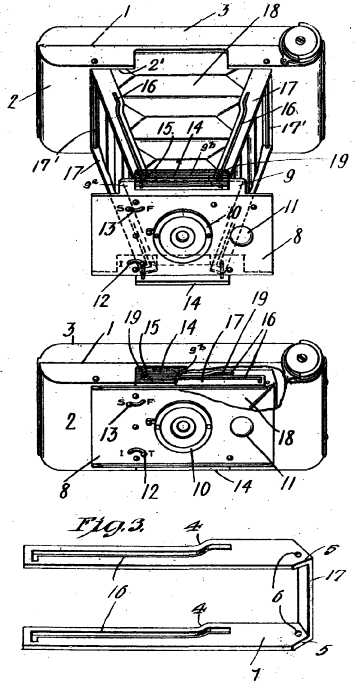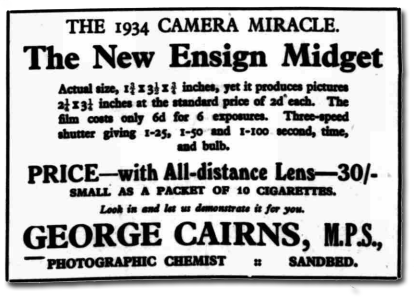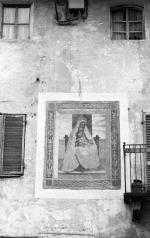|
Houghton Ensign Midget 55 |
Manufactured or assembled in United Kingdom from (Circa) 1934 to (After) 1939.
Index of rarity in France: Rare (among non-specialized garage sales)
Inventory number: 7510
See the complete technical specifications
Chronology of cameras Houghton
In 1836, G. Houghton, English and A. Claudet, French, create the company Claudet & Houghton which manufactures lenses and other glass-based products. In 1867, Claudet died and the son of G. Houghton replaced him, the company became G. Houghton & Son. It moved to London around 1903 to produce Ensign branded film and became Houghton's Ltd, the Ensign logo was created.
In 1905, a camera production factory opened. In 1908, it was the largest in Great Britain with over 1,000 employees. In 1915, the company joined with Butcher's & Son to form the Houghton-Butcher Manufacturing Company. The camera lines of both companies continue to be produced under their own brand.
In 1930, a distribution company was created, it took the name of its brand and became Ensign Ltd.
In September 1940, Ensign's offices were bombed and destroyed, the company was liquidated in 1942. Houghton & Butcher's continued in business claiming ownership of the Ensign trademark. The production of materials for war prevents research into new products. In 1945, the liquidators of Ensign Ltd agreed to the creation of Barnet Ensign Ltd which brought together Houghton & Butcher's and Elliot Ltd (manufacturer of Barnet films).
In 1948, the lens manufacturer Ross joined the group to form Barnet Ensign Ross Ltd, then to become Ross Ensign Ltd in 1951. This last company produced expensive and high quality cameras: like the Selfix, the Autorange. The managers are convinced of the best quality of their products on medium format film (120) and do not make any research on 35 mm. Their cameras, which are expensive and aging, are overwhelmed by German 35mm cameras. The company disappeared in 1961.
 The Ensign Midget are the result of Houghton's collaboration with Magnus Niell, a Swedish inventor who emigrated to the United States. This collaboration had already begun with the Ticka Watch (1906) and the Ensignette series (1909).
The Ensign Midget are the result of Houghton's collaboration with Magnus Niell, a Swedish inventor who emigrated to the United States. This collaboration had already begun with the Ticka Watch (1906) and the Ensignette series (1909).In 1918, Niell obtained a British patent (N° 117399) for a pocket camera: foldable, with nothing sticking out or catching, easy to handle and preventing accidental shots. In 1934, It resulted in a camera smaller than the smallest Ensignette. It will be the Ensign Midget.
Advertisements in Great Britain, from 1934, presented their release as an "exciting event", emphasizing their size ("to always have with you like a watch") and their performance. The success is immense supported by intense and varied publicity. This explains that this camera can still be found quite easily.
At the start of the war, in 1939, the Houghton advertisement spoke of a camera suitable for "men in the field" and in 1940 "of a specialized wartime camera".
In September 1940, Houghton's workshops were bombed. In 1941 the production of Midget was abandoned, the film meanwhile, will be produced until the 1950s.
Ensign Midget Models
The Ensign Midget were designed to be compact, aesthetic and ergonomic.
They measure 91 x 44 x 21 mm (closed) and 91 x 70 x 65 mm (unfolded). The viewfinder folding completely allows this mini size. The deployment of the camera is easy and the scissors are self-locking.
Their body is hingeless, with a sliding flat latch and a tiny back opening stud. The trigger is protected by the front plate.
The film to be used is the 35 mm E10, which allows to obtain six 35 x 45 mm views. On some models, there is a flap inside the darkroom which lowers when the bellows is unfolded and which rises and comes to protect the sensitive surface of the film when the bellows is folded back.
Whether it is the camera, its user manual or the packaging, everything is neat and beautiful.
In 1934, the first two models, called A/D and A/N, were released. In 1935, a simplified model was marketed, the 22. Consequently, the A/D and A/N models became the 33 and 55, the number corresponding to the selling price in shillings, which would cause some problems for Houghton when the prices will increase. The same year, a special version of the 33 and 55 was announced in honour of the Silver Jubilee of King George V. These cameras had a silver finish (the other models were black). They are called S33 and S55 (S for Silver) and supplied in a special luxury box.
Models A/D, 33 and S33 and A/N, 55 and S55
The two models are very similar and differ essentially by the lens and the shutter.
They have in common a pivoting spool holder (patents 14,489 and 28,464 of 1908), one end of which can be lifted. The winding key can be slid. The set greatly facilitates the release of the film.


They have two viewfinders: a sports type and a pivoting rectifier type hidden behind the faceplate. The sports type consists of a pivoting eyepiece at the rear of the body and a folding and folding front frame on the top of the front face. A leaf spring automatically folds the frame.

A pivoting stand allows horizontal and vertical shooting.
The decoration of the front panel consists of a varnished brass diamond on which the settings are engraved as well as the model name Ensign Midget. On the A/N, 55 and S55, there is also an indication, in red, of the focusing distances.
On the A/D, 33 and S33, the lens has two apertures, marked as Small and Large. These are two holes of different diameter on a disc. The focal length of the fixfocus lens is approximately 53 mm.
The shutter allows speeds 1/25, 1/50, 1/100, and one or two times exposure.
On the A/N, 55 and S55, the lens is an Ensar Anastigmat with an iris diaphragm opening from f/6.3 to f/22, the focal length is around 53 mm. A helicoid allows to adjust the focus from 3 feet (there are models graduated in feet and others in meters).
The shutter allows speeds 1/25, 1/50, 1/100, and one or two times exposure.
Model 22
The body of this model is the same as the others, but there is no film press or swivel spool holder. There is no crutch. The viexfinder is a simple pivoting frame at the rear of the body, with no frame at the front. The lens is a single aperture fixfocus.
The speeds are the instantaneous and time exposure
The decoration of the front face consists of a rectangle in varnished brass with vertical stripes and a diagonal Ensign Midget headband.

This copy of the Ensign Midget 55 is graduated in feet, but there is the same model graduated in meters.

Interesting links or bibliography :
Add a link or element of bibliography, a picture taken with this camera, a picture of box or an ads about this camera
Your photos taken with the same camera:
Cameras from Ebay France (Houghton) (Uploaded each 3 hours)








